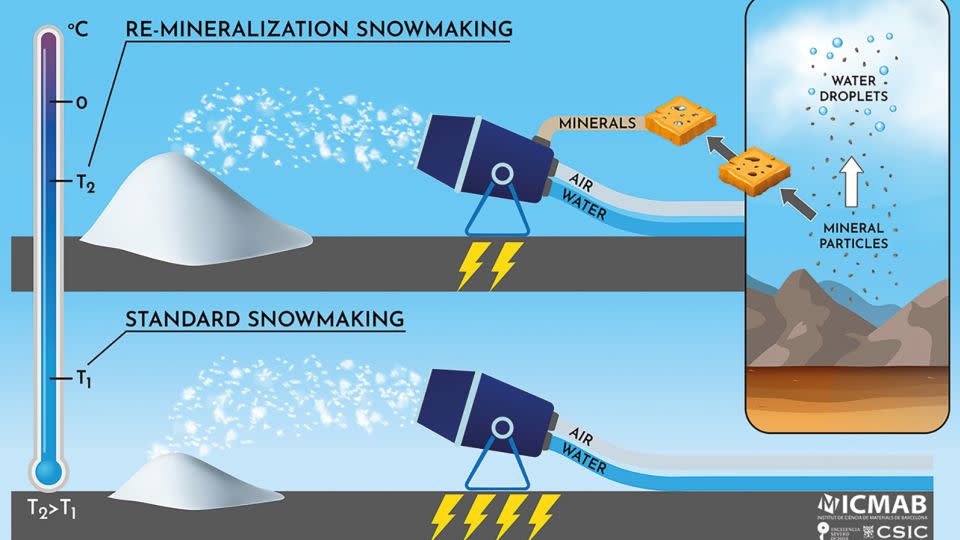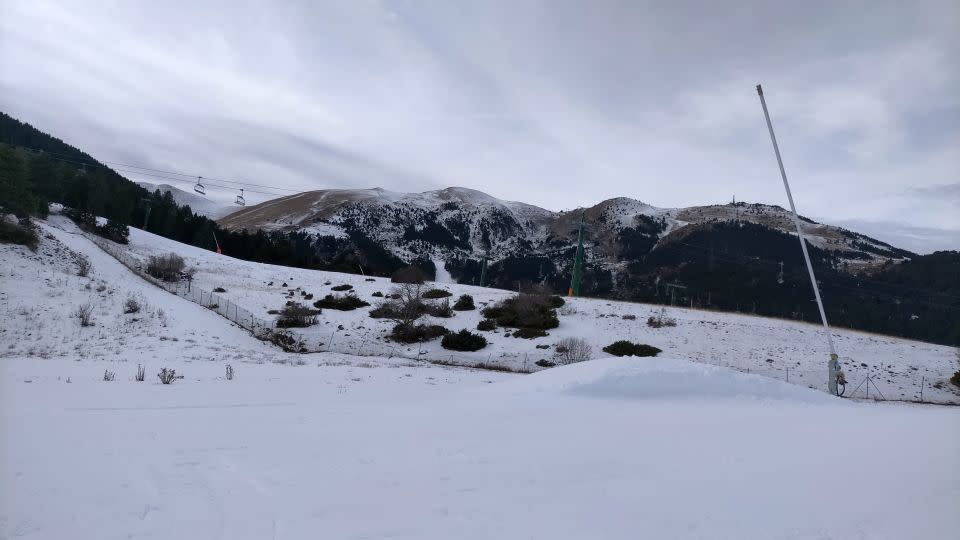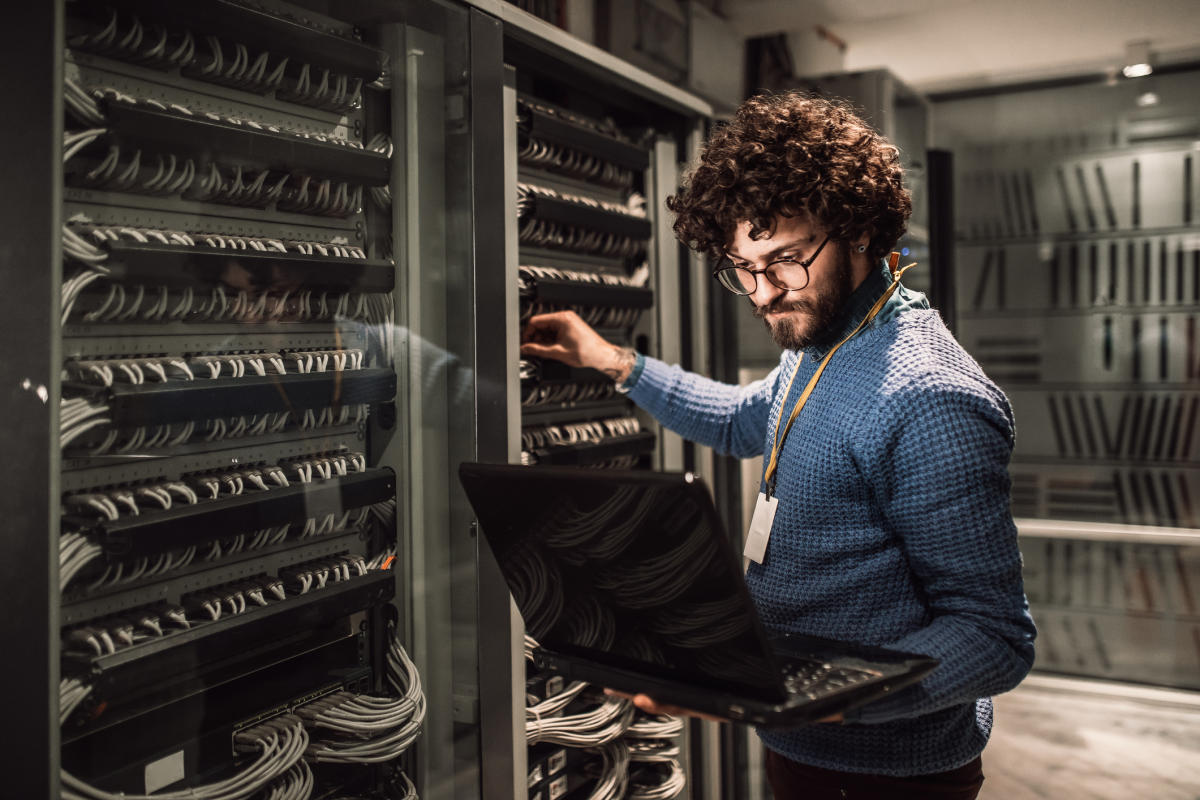Nestled in the Pyrenees mountains, La Molina is Spain’s oldest ski resort. It boasts the biggest superpipe in the Pyrenees and its slopes have hosted high-profile events, from the Alpine Skiing World Cup to the Snowboard World Championships. But La Molina now faces an existential threat: A dearth of snow.
As global temperatures rise, the resort, like many around the world, is being forced to rely increasingly on artificial snow.
But fake snow comes at a cost. It is both water and energy intensive — a difficult combination anywhere but especially in a country grappling with a prolonged and severe drought fueled by climate change.
That’s why La Molina will spend the next three years testing a new snowmaking technique that promises to be far less resource intensive, as well as being able to produce snow at warmer temperatures — increasingly important as some resorts are approaching temperatures too warm to make even fake snow viable.
Called the Snow Laboratory, and run by the Barcelona Institute of Materials Science (ICMAB-CSIC) and FGC Turisme, which manages public ski slopes, the project will make fake snow by adding a mineral to the water going into snow guns, the machines that pump out water and air at high pressure to create snow.
The idea is to mimic processes that happen in the clouds, said Albert Verdaguer, the scientist at ICMAB-CSIC who has been leading the project.
Ice is formed in the atmosphere from water droplets in clouds by a process called “ice nucleation.” Pure water droplets can remain unfrozen in clouds at temperatures as low as minus 38 degrees Celsius. But ice nucleation can happen at much higher temperatures when the water droplets interact with particles in the atmosphere, such as aerosols or dust, triggering them to freeze.
A couple of years ago, Verdaguer read a research paper which found that one mineral — feldspar — was particularly efficient at this process and could trigger the freezing of water droplets at temperatures close to zero degrees.
It set off a lightbulb: What if feldspar could help make snowmaking more efficient? “We thought, why don’t we take advantage of that?” he told CNN.

During lab tests, Verdaguer and his team found the technique reduced energy costs by around 30% and was able to produce snow at temperatures around 1 to 1.5 degrees higher than traditional methods.
They were also able to get a better “conversion ratio,” Verdaguer said, referring to the volume of snow that comes out of the guns in relation to the amount of water that goes in.
Usually, it’s around 75%, he said, as some water remains in the gun or doesn’t freeze and is blown away. The Snow Laboratory expects to increase that to 90%.
Roughly a Coke can-sized amount of feldspar — an abundant mineral which makes up roughly 60% of the Earth’s crust — would keep two snow guns running all season, said Verdaguer.
An industry in peril
Spain has been struggling with scorching heat waves an d a years-long drought, and Catalonia, the region where La Molina is located, has been particularly hard hit. It’s “one of the most intense droughts in recent years,” said Ramón Pascual Berghaenel, a meteorologist at Spain’s weather agency AEMET.
But La Molina is far from the only ski resort trying to plot a future in a warmer, dryer world. An unusually warm winter last year left ski resorts across Europe bare of snow, and this year, resorts in the Indian Himalayas lay empty as a lack of snow kept tourists away.
“Of course, there are shifts and changes year on year, but the long term trend (for snow) is decline,” said sports ecologist Madeleine Orr, who is not involved in the Snow Laboratory. Over the past four decades, human-caused global warming has led to reduced snow across much of the Northern Hemisphere, a recent study shows.
These changes mean artificial snow, used by resorts for decades, is increasingly becoming a lifeline. “Current best estimates are that 95% of ski resorts rely on snowmaking to some extent to remain viable,” Orr told CNN.
But as temperatures rise, there are questions over how viable snowmaking will be in the future. When it’s not cold enough, the machines simply won’t work.
That’s why Snow Laboratory’s new technique is so appealing.
The science makes sense, said Jordy Hendrikx, a leading snow scientist and the chief scientific advisor for Antarctica New Zealand. “It’s a question of whether that can be scaled,” Hendrikx, who is not involved in the Snow Laboratory, told CNN.
That’s exactly what the La Molina project aims to do — to see if the lab results can be replicated in the real world.
For the past few weeks, Verdaguer and colleagues have been setting up the snow guns at the resort. The water will come from a reservoir which fills with melted snow from the mountains in the spring and isn’t used for drinking water.
As well as testing snowmaking efficiency, the project will undertake environmental tests to make sure there are no adverse impacts. Verdaguer is confident there won’t be, as feldspar is already widely used in glassmaking, ceramics and paints.
“If this new technology is able to produce snow with less water, and without adding extra chemical agents … that could be a huge win,” Orr said.
But Hendrikx warned that even if the technique lives up to its promise, it may not be enough. As temperatures and humidity levels continue to climb, he said, “the improvement you’ve got to make has to be quite significant to outweigh what the natural environment is producing.”
More broadly, Hendrickx believes snowmaking is a “maladaptation,” an attempt to adapt to climate change that can end up having a harmful effect. “You’re solving a problem locally, but you’re increasing the problem globally by your energy usage.”
Resorts could use green energy for fake snow, but as the world electrifies, Hendrikx said, this clean energy could arguably be better used elsewhere, “rather than making snow for a very small percentage of the population.”


And this hits on a bigger problem: Declining snowpack is a problem far beyond the ski industry. “Snow represents our water towers,” said Hendrikx, acting as free storage when people need it most. If it falls as rain, or melts earlier than usual, “we don’t have that trickle down later in the spring and the summer when we really need it.”
Hendrikx gets why resorts make snow. Mountain economies rely on it. and Tourists have come to see snow as a resource that can be bent to their desire to ski or snowboard on powdery white slopes at certain times of the year.
Ultimately, resorts are not going to stop making snow any time soon, he said, so “any way we can find more efficient ways to do that, let’s get on it,” he said.
The next three years will see Snow Laboratory test its technique at La Molina but also eventually at two other ski resorts in the region to explore how well it works under different conditions.
The hope is this technology will give breathing room to struggling mountain communities that depend heavily on snow, Vedaguer said.
“We don’t want all the ski resorts to be closed in five years or 10 years, and not have had time to really think something through for the economy of the regions,” he said. “This is just to give us some time.”
For more CNN news and newsletters create an account at CNN.com

Dr. Sarah Adams is a scientist and science communicator who makes complex topics accessible to all. Her articles explore breakthroughs in various scientific disciplines, from space exploration to cutting-edge research.







